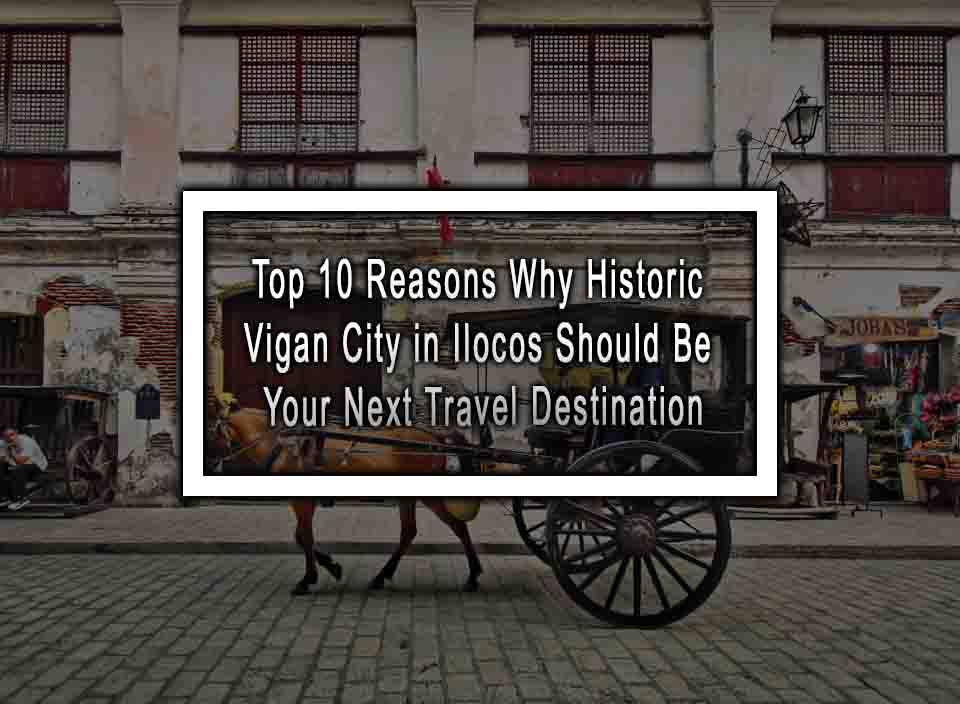Ready to Make History? Pack Your Bags for Vigan City in Ilocos!
Captivating you with its link to the past, Vigan City transports you to the heart of Ilocos Sur. You are going on a vivid historical experience as you meander through its immaculately kept streets, not just having a leisurely stroll. Recognized as a UNESCO World Heritage Site, Vigan is a veritable gold mine of Spanish colonial-era culture, customs, and architectural beauty. This curated map is the ideal way for history aficionados, culture vultures, and adventurous tourists to discover Vigan’s timeless beauty, heritage building by historic building. Let’s explore the top ten treasures that make Ilocos’ Historic Vigan City such a wonderful destination that it should be on your travel bucket list.
1. Calle Crisologo

Calle Crisologo, nestled in the heart of historic Vigan City in Ilocos, offers a vivid glimpse into the Philippines’ colonial past. This historic cobblestone street is lined with beautifully preserved Spanish-era buildings, evoking a bygone era with their intricate facades and antique accents. As visitors stroll through its length, horse-drawn carriages, locally known as ‘calesas,’ clip-clop alongside, enhancing the street’s timeless ambiance. Vigan itself is a UNESCO World Heritage Site, acclaimed for its unique fusion of Asian building design and construction with European colonial architecture and planning. Calle Crisologo, both visually striking and steeped in history, serves as the cultural centerpiece of the city, celebrated for its living heritage and preserved traditions.
Trivia
- Calle Crisologo is a key feature in the historic city of Vigan, which was established in the 16th century and is one of the few Hispanic towns left in the Philippines.
- The street and its surroundings were declared a UNESCO World Heritage Site in 1999, recognizing their outstanding preservation of Philippine colonial architecture.
- Much of the architecture along Calle Crisologo reflects the ‘Bahay na Bato’ design, a stone house style that merges native Filipino and Spanish architectural elements.
2. Syquia Mansion Museum

The Syquia Mansion Museum, located in the heart of Historic Vigan City in Ilocos, is a grand ancestral home turned museum that offers a glimpse into the opulent lifestyle of the Philippines’ colonial elite. This beautifully preserved mansion boasts antique furniture, intricately carved wooden panels, and a stunning collection of original artworks. Its architecture reflects the unique blend of Chinese, Spanish, and Filipino influences typical of the region’s historic structures. The mansion, named after the affluent Syquia family, who were prominent figures in Philippine history, serves as a testament to the cultural heritage and aristocratic past of Vigan City, offering visitors an immersive educational experience.
Trivia
- The Syquia Mansion was once the residence of Elpidio Quirino, the sixth President of the Philippines, who married into the Syquia family.
- It features a collection of rare, centuries-old Chinese porcelain, highlighting the vibrant trading history between the Philippines and China.
- The mansion’s architectural design includes sliding capiz shell windows and ventanillas, a unique colonial-era detail for ventilation and privacy.
3. Vigan Cathedral (St. Paul’s Metropolitan Cathedral)

In the center of Vigan City, Ilocos, the Vigan Cathedral, also called St. Paul’s Metropolitan Cathedral, is a symbol of religious and historical significance. The cathedral, which was built during the Spanish colonial era in the sixteenth century, is a striking example of the rich history and cultural diversity of the area. Its architecture is a combination of European Baroque with distinctive earthquake-resistant features found in the Philippines, a style known as “earthquake baroque.” Deeply ingrained in the residents’ spiritual psyche, the church building functions as the administrative center of the Roman Catholic Archdiocese of Nueva Segovia. The cathedral’s octagonal bell tower, which is located close by and has withstood centuries of environmental obstacles, complements its magnificent façade.
Trivia
- The original structure was erected by the Spanish Juan de Salcedo in 1574 but was severely damaged by earthquakes, leading to its reconstruction in the 18th century.
- Vigan Cathedral is home to the remains of the Ilocano martyr and saint, Pedro Bautista Blasquez, which attracts numerous devotees.
- It features a majestic “Retablo,” or altar piece, which is intricately carved and gilded, standing as a stunning example of Philippine religious art.
Must see the Cathedrals in Manila Inspiring history and faith.
4. Bantay Bell Tower

Bantay Bell Tower stands as an iconic symbol of historic Vigan City in the Ilocos region, offering a panoramic view of this UNESCO World Heritage Site. Erected in 1591, this imposing structure was originally part of the Bantay Church complex, serving as a watchtower against invasions. Its resilient architecture has withstood earthquakes, wars, and the test of time, symbolizing the enduring spirit of the Filipino people. Resembling a fortress, the bell tower has a rustic charm with its aged brick walls and the classic baroque design that Vigan City is well-known for. Visitors can ascend its steps to be greeted with breath-taking vistas of the Ilocos landscape, making it a must-visit for history enthusiasts and travelers alike.
Trivia
- The name “Bantay” translates to “guard” in English, emphasizing its original role as a watchtower.
- It is considered one of the oldest bell towers in the Ilocos Region, exemplifying four centuries of history.
- The bell tower has survived several earthquakes, including a 7.8-magnitude quake in 1983, showcasing its exceptional durability and construction.
5. Baluarte Zoo

Baluarte Zoo, situated in the historic Vigan City in Ilocos, is a popular attraction established by local politician and businessman Chavit Singson. This open zoo stretches over a vast area of 80 hectares and serves as home to a variety of wildlife, both exotic and endemic. It operates with the mission of educating visitors about animal conservation while also providing a recreational space for family and friends. The zoo boasts interactive exhibits, picturesque landscapes, and some opportunities to get close to the animals. With free admission, it offers an accessible experience for everyone to learn about and appreciate the diverse species that live within it.
Trivia
- Baluarte Zoo offers free admission to its visitors, making it a popular destination for tourists and locals alike.
- One of the main attractions within Baluarte is the Safari Gallery, where a fascinating collection of mounted animals, hunted by Governor Singson himself, is on display.
- Originally a personal collection of Governor Chavit Singson, Baluarte evolved into a full-fledged public zoo. His commitment to sharing this experience with the public reflects his dedication to wildlife and community service.
6. Hidden Garden of Vigan

Tucked away in the quaint historic Vigan City in Ilocos, the Hidden Garden of Vigan is a verdant oasis brimming with a variety of plants and flowers. This serene botanical garden is an enchanting escape, showcasing a diverse selection of flora, including tropical blooms and rare plant species. It offers a tranquil retreat for nature lovers and those seeking solace from the hustle and bustle of city life. The garden’s lush pathways, accented with antique accents and rustic charm, lead visitors on a journey through a green wonderland. It is not only a place to appreciate nature’s bounty but also reflects the rich cultural backdrop of the historic city of Vigan.
Trivia
- The Hidden Garden of Vigan features a range of medicinal plants, educating visitors on the healing properties of various herbs.
- The Hidden Garden is also home to a collection of bonsai trees, some of which are quite old and have been intricately shaped over the years, highlighting the skill and patience of bonsai artists in the region.
- A koi pond can be found within the premises, adding to the overall peaceful atmosphere and offering a tactile experience for guests who can feed the fish.
7. Plaza Salcedo

Plaza Salcedo is an iconic public space located in the heart of historic Vigan City in Ilocos, Philippines. This picturesque square embodies the rich cultural heritage of the region, with its Spanish colonial influence evident in the surrounding architecture and cobbled streets. Named after the Spanish conquistador Juan de Salcedo, who founded the city in 1572, the plaza remains a focal point for social gatherings, historical commemorations, and vibrant festivities. It is set against the backdrop of the majestic St. Paul’s Metropolitan Cathedral, contributing to the area’s serene and reverent atmosphere. Lined with centuries-old structures, Plaza Salcedo is a testament to Vigan City’s illustrious past, recognized as a UNESCO World Heritage Site for its exceptional preservation of colonial urban landscape.
Trivia
- It hosts the annual “Binatbatan Festival of the Arts,” where locals showcase traditional crafts, particularly the art of Abel Iloco weaving.
- The Vigan Heritage Conservation Program maintains the authenticity of Plaza Salcedo, leading to Vigan City’s recognition as one of the New 7 Wonders Cities in 2014.
- Every year during Holy Week, Plaza Salcedo serves as the venue for a poignant reenactment of the “Via Crucis,” or the Way of the Cross, attracting devotees and tourists alike.
8. Crisologo Museum

The Crisologo Museum, nestled in the heart of historic Vigan City in Ilocos, stands as a testament to the robust history of the Philippines. This storied museum once served as the residence of the Crisologo family, prominent political figures in the region. It has been preserved and converted into a public museum to offer a window into the life and times of the family, especially highlighting the late Congressman Floro S. Crisologo‘s political career. Visitors can explore the original furnishings, memorabilia, and personal collections of the family, which vividly encapsulate the socio-political landscape of their era. The museum’s Spanish colonial architecture also embodies Vigan’s rich historical fabric, making it a pivotal landmark in the city’s UNESCO World Heritage Site.
Trivia
- The assassination of Congressman Crisologo took place in Vigan’s St. Paul’s Cathedral in 1970, a pivotal event that is extensively covered in the museum.
- Among the many artifacts, the bullet-ridden car of Floro Crisologo is on display, serving as a stark reminder of the violent political climate of the period.
- The Crisologo Museum houses a collection of antique household items, showcasing how Filipino aristocrats lived during the 19th and 20th centuries.
9. Empanada and Okoy Street Food

Empanadas and Okoy are quintessential street foods that have embedded themselves into the culinary tapestry of the Philippines, notably in the historic Vigan City in Ilocos. Empanadas are delectable, crescent-shaped pastries filled with savory mixtures ranging from seasoned meats to colorful vegetables and beans. Authentic Vigan empanadas are distinct, often containing Vigan longganisa (local sausage) and green papaya, then deep-fried to achieve a crispy, golden exterior. Okoy, on the other hand, is a crispy shrimp fritter, traditionally made with small shrimp, sometimes shell-on, mixed into a batter with vegetables like shredded pumpkin and sweet potato, then fried until crisp and enjoyed with a vinegar-based dip.
Trivia
- Vigan empanadas are typically dyed orange using achuete (annatto) seeds, which also impart a subtle, earthy flavor.
- Okoy is traditionally served with a spiced vinegar dipping sauce called “sukang maanghang,” which complements the savory flavors of the fritters.
- Vigan, a UNESCO World Heritage City, is renowned for its Spanish colonial and Asian architecture, as well as its food heritage.
10. Burnay Jars & Pottery Making

Burnay Jars, the traditional Ilocano earthenware, are emblematic of Vigan’s rich craft heritage in Ilocos. These sturdy, well-crafted jars were created using pre-colonial techniques preserved by local artisans in the historic Vigan City. Their making begins with the meticulous selection of sticky clay, which is then molded on a potter’s wheel and shaped by skilled hands. The formed jars are then sun-dried and baked in wood-fueled, dragon kiln-like brick furnaces, undergoing a high-temperature firing that ensures their remarkable durability. Historically, these jars were used for storing grains, wine, and bagoong (fermented fish sauce), highlighting their significance in the traditional Filipino way of life. Today, they are appreciated for both their functionality and as decorative, culturally significant pieces.
Trivia
- Burnay jars are notable for their natural brown color, which is a result of the iron-rich clay they are made from and the high-fire process.
- Unlike terracotta pots, burnay jars are non-porous, making them suitable for fermenting fish sauce and storing liquids.
- Each jar is unique due to the artisan’s personal touch and the unpredictable nature of the kiln’s flame patterns, making them one-of-a-kind works of art.
Bid Farewell or Better Yet, Return Soon: The Enduring Allure of Vigan’s Heritage
Historic Vigan City in Ilocos is not just a location; it’s an experience. With each footstep on its cobblestone paths, visitors travel back in time and weave new memories among echoes of the old. The cultural and historical depth of Vigan is timeless, and its legacy is yours to explore and cherish. Whether through the lens of your camera, the taste on your tongue, or the stories you’ll carry home, Vigan ensures a place in your heart. Engage with the past, envision the future, and extend your journey beyond the here and now. Vigan City awaits—embrace its embrace, etch its heritage in your narrative, and share the wonder that has withstood centuries.
Historic Vigan City in Ilocos FAQs
Here are the most common questions about historic Vigan City in Ilocos.
1. What languages are spoken in Vigan City?
The predominant language spoken in Vigan is Ilocano, which is the language of the Ilocos region. However, given that Vigan is a popular tourist destination, many locals also speak Filipino (Tagalog) and English, especially in areas frequented by tourists such as hotels, restaurants, and tourist attractions.
2. Is it safe to visit Vigan City?
Yes, Vigan City is generally considered safe for tourists. However, it is always prudent to take standard safety precautions when traveling.
3. How accessible is Vigan City?
Vigan City is accessible by land transportation, with bus companies offering direct routes to Vigan from Manila and other parts of Luzon. The nearest airport is Laoag International Airport, which is about a 2-hour drive from Vigan.
4. What is the best time to visit Vigan City?
The best time to visit is during the dry season, from November to April. However, Vigan City also celebrates festivals like Vigan City Fiesta in January and the Viva Vigan Festival of the Arts in the first week of May, which showcase the city’s cultural richness.
5. Are there local tour guides and tours available?
Yes, local tour guides are available and often recommended to get deeper insights into the history and culture of Vigan. Many guides are knowledgeable about the intricacies of the city’s past and can provide rich storytelling as they lead you through the streets and landmarks. There are various types of tours available, from walking tours of the historic district to calesa tours and food tours focused on local cuisine.












